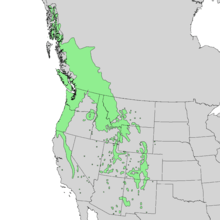Acer glabrum
| Acer glabrum | |
|---|---|
| | |
| A. glabrum subsp. douglasii, Olympic National Forest | |
| Scientific classification | |
| Kingdom: | Plantae |
| (unranked): | Angiosperms |
| (unranked): | Eudicots |
| (unranked): | Rosids |
| Order: | Sapindales |
| Family: | Sapindaceae |
| Genus: | Acer |
| Species: | A. glabrum |
| Binomial name | |
| Acer glabrum Torr. 1827 | |
 | |
| Natural range | |
| Synonyms | |
|
List
| |
Acer glabrum is a species of maple native to western North America, from southeastern Alaska, British Columbia and western Alberta, east to western Nebraska, and south through Washington, Oregon, Idaho, Montana and Colorado to California, Arizona and New Mexico.[1]
Description
Acer glabrum is a small tree growing to 10 metres (33 ft) tall, with a trunk up to 20–30 centimetres (7.9–11.8 in) diameter. The leaves are 2–10 centimetres (0.79–3.94 in) broad, three-lobed (rarely five-lobed), variable in the depth of lobing, occasionally so deeply lobed as to be divided into three leaflets; the lobes have an acute apex and a coarsely serrated margin. The flowers are produced in corymbs of five to ten, yellowish-green, at the same time as the new leaves in spring. The fruit is a samara or winged seed. These develop in pairs at an angle of less than 45° when mature.[2][3]
Varieties
There are four to six varieties, some of them treated by some authors at the higher rank of subspecies:[1][3][4]
- Acer glabrum var. glabrum (syn. subsp. glabrum; Rocky Mountain maple)– Rocky Mountains, Montana to New Mexico
- Acer glabrum var. diffusum (Greene) Smiley (syn. subsp. diffusum (Greene) A.E.Murray; Rocky Mountain maple) – eastern California, Nevada, Utah
- Acer glabrum var. douglasii (Hook.) Dippel (syn. subsp. douglasii (Hook.) Wesm.; Douglas maple) – Alaska south to Washington and Idaho
- Acer glabrum var. greenei Keller (Greene's maple) – endemic-central California
- Acer glabrum var. neomexicanum (Greene) Kearney & Peebles (syn. subsp. neomexicanum (Greene) A.E.Murray; New Mexico maple) – New Mexico
- Acer glabrum var. torreyi (Greene) Smiley (syn. subsp. torreyi (Greene) A.E.Murray; Torrey maple) – endemic-Northern California
Ecology
Acer glabrum is plentiful in many parts of the Rocky Mountains, often growing with Ponderosa Pine, Douglas-fir, and Quaking Aspen.[5]
Uses
Some Plateau Indian tribes drink an infusion of Douglas maple as a treatment for diarrhea.[6] Ramah Navajo use an infusion of the glabrum variety for swellings, and also as a "life medicine", or panacea.[7][8]
Further reading
- Justice, DE; Reid, AR; Bohm, BA (1995). "Vacuolar flavonoids of rocky mountain maple, Acer glabrum torrey (Aceraceae)". Biochemical Systematics and Ecology. 23 (3): 263-265. doi:10.1016/0305-1978(95)00014-L.
References
- 1 2 Germplasm Resources Information Network: Acer glabrum
- ↑ Plants of British Columbia: Acer glabrum
- 1 2 Jepson Flora Project: Acer glabrum var. diffusum, var. greenei, var. torreyi
- ↑ USDA Plants Profile: Acer glabrum
- ↑ USDA Forestry Service, Fire Effects Information: Acer glabrum
- ↑ Hunn, Eugene S. (1990). Nch'i-Wana, "The Big River": Mid-Columbia Indians and Their Land. University of Washington Press. p. 351. ISBN 0-295-97119-3.
- ↑ Vestal, Paul A. 1952 The Ethnobotany of the Ramah Navaho. Papers of the Peabody Museum of American Archaeology and Ethnology 40(4):1-94 (p. 36)
- ↑ http://herb.umd.umich.edu/herb/search.pl?searchstring=Acer+glabrum
| Wikimedia Commons has media related to Acer glabrum. |